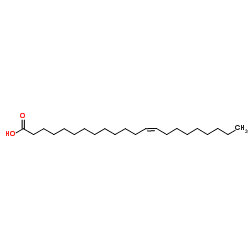Formula C22H42O2 Boiling point 381.5 °C Appearance White waxy solid | Molar mass 338.57 g/mol Density 860 kg/m³ | |
 | ||
What is erucic acid
Erucic acid is a monounsaturated omega-9 fatty acid, denoted 22:1ω9. It has the formula CH3(CH2)7CH=CH(CH2)11COOH. It is prevalent in wallflower seed with a reported content of 20 to 54% in high erucic acid rapeseed oil, and 42% in mustard oil. Erucic acid is also known as cis-13-docosenoic acid and the trans isomer is known as brassidic acid.
Contents
- What is erucic acid
- What does erucic acid mean
- Uses
- Biochemistry
- Health effects
- Low erucic acid rapeseed
- References
What does erucic acid mean
Uses
Erucic acid has many of the same uses as mineral oils, but it is more readily biodegradable than some. It has limited ability to polymerize and dry for use in oil paints. Like other fatty acids, it can be converted into surfactants or lubricants, and can be used as a precursor to biodiesel fuel.
Derivatives of erucic acid have many further uses, such as behenyl alcohol (CH3(CH2)21OH), a pour point depressant (enabling liquids to flow at a lower temperature), and silver behenate, for use in photography.
Biochemistry
Erucic acid is produced by elongation of oleic acid via oleoyl-coenzyme A and malonyl-CoA. Erucic acid is broken down into shorter-chain fatty acids in the human liver by the long-chain acyl CoA dehydrogenase enzyme.
Health effects
While studies done on laboratory animals in the early 1970s show that erucic acid appears to have toxic effects on the heart at high enough doses, an association between the consumption of rapeseed oil and increased myocardial lipidosis, or heart disease, has not been established for humans. While there are reports of toxicity from long-term use of Lorenzo's oil (which contains erucic acid and other ingredients), there are no reports of harm to people from dietary consumption of erucic acid.
Publication of animal studies with erucic acid through the 1970s led to governments worldwide moving away from oils with high levels of erucic acid, and tolerance levels for human exposure to erucic acid have been established based on the animal studies.
In 2003, Food Standards Australia set a provisional tolerable daily intake (PTDI) for an average adult of about 500 mg/day of erucic acid, extrapolated based on "the level that is associated with increased myocardial lipidosis in nursing pigs." "There is a 120-fold safety margin between this level and the level that is associated with increased myocardial lipidosis in nursing pigs. The dietary exposure assessment has concluded that the majority of exposure to erucic acid by the general population would come from the consumption of canola oil. The dietary intake of erucic acid by an individual consuming at the average level is well below the PTDI, therefore, there is no cause for concern in terms of public health and safety. However, the individual consuming at a high level has the potential to approach the PTDI. This would be particularly so if the level of erucic acid in canola oil was [sic] to exceed 2% of the total fatty acids."
Low erucic acid rapeseed
Food-grade rapeseed oil (also known as canola oil, rapeseed 00 oil, low erucic acid rapeseed oil, LEAR oil, and rapeseed canola-equivalent oil) is regulated to a maximum of 2% erucic acid by weight in the USA and 5% in the EU, with special regulations for infant food.
